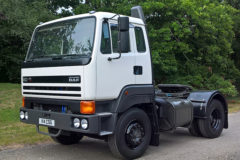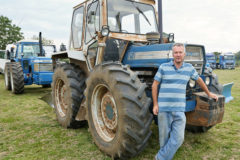Unique ‘Doe 3000’ tractor build
Posted by Chris Graham on 17th January 2020
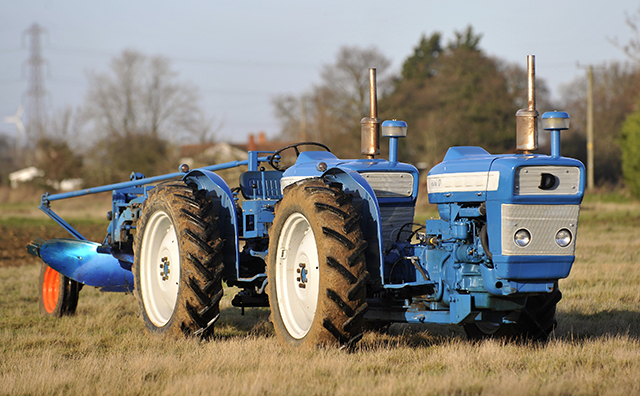 Michael Moore is the proud owner of a unique, home-built, Doe-style, four-wheel-drive, articulated tractor. Chris Graham meets the man and his fantastic machine.
Michael Moore is the proud owner of a unique, home-built, Doe-style, four-wheel-drive, articulated tractor. Chris Graham meets the man and his fantastic machine.
Restoration stories are nothing unusual these days in the classic and vintage tractor world. Plenty of owners are working hard to produce beautifully renovated machines that, in many cases, are actually better than what left the factory. However, vehicle building projects are a good deal more out of the ordinary, especially when they involve transforming two tractors into one. But that’s exactly what Michael Moore has done in a herculean task that involved combining two tractors to create one machine. His idea was inspired by a long-held admiration for those articulated, four-wheel-drive and powerful workhorses produced by Essex-based Ernest Doe & Sons Ltd during the 1950s. What he’s produced is both a significant engineering feat and a testament to his design and workshop skills.
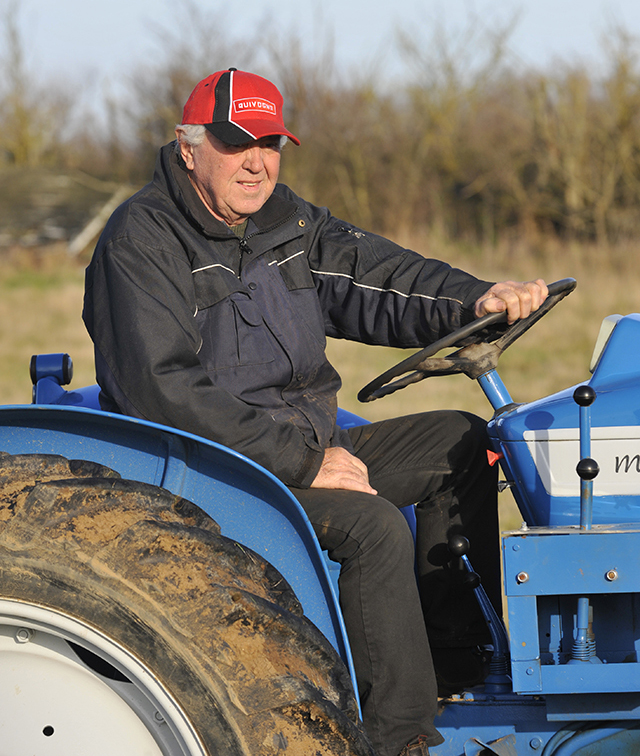
Michael says that it’s harder to plough well with ‘Mini D’ than with a conventional tractor, but he’s getting better at it and really enjoying the challenge
Impressive achievement
This achievement is even more impressive given the fact that Michael isn’t a formally trained engineer, and has had no experience in the commercial vehicle manufacturing sector. But, at the same time, he’s far more than just an enthusiastic amateur, having spent several years designing, manufacturing and selling specialist mole ploughs and other agricultural implements.
“I started by working on a farm for a year after leaving school, then joined my father, who was an agricultural contractor,” Michael explained. “The first big tractor I bought was a Massey Ferguson 1200, back in the mid.1970s, which I used for contracting work all over south Essex. At the time, moling was widespread and grant-aided. With my new tractor, I thought maybe I could offer this service and fully utilise the big tractor.
“I borrowed a single-beam unit to try, but my tractor wouldn’t pull it. So, after giving the problem some thought, decided that switching to a twin-beam set-up might be better. I built a prototype and it worked beautifully with my tractor. I was then able to demonstrate my new design at a Farmer’s Weekly-sponsored land drainage event in Colchester, and there was so much interest in it that I decided to start building the mole ploughs commercially. I wasn’t set up to do so, so I got an engineering shop to produce the first few examples.”
Ploughing on!
“Things went from strength to strength and, in no time, we had enough orders to set up our own workshop, employ a full-time welder/fabricator, and the Michael Moore Mole Plough was born. The business grew organically and, by the early 1980s, had taken over from the contracting work altogether.
“We branched out into the manufacture of different sorts of agricultural implements, as I spotted gaps in the market, but it was while I was out demonstrating our products and chatting to farmers, that my interest in old tractors started to develop. Many farms I went to had an ageing tractor in the barn and, as I was driving an articulated lorry, I’d often make a cash offer for those I fancied and was able to take them home there and then.
“My initial idea was to build a collection of restoration projects that would keep me busy with challenging projects, once I retired, and I probably bought 25 machines during that period. When I retired in 2004, I started bringing them back to life. One of the first I completed was a Roadless 45, which I still own. I also started to get into the competition ploughing scene which, initially, I found quite a challenge.
“With my contracting background, I couldn’t believe that competitors were given four hours to plough a single plot – I’d been used to doing things as quickly as possible. The exacting nature of the techniques involved came as quite an eye-opener, but I soon got hooked, and have enjoyed some decent competition results since.”
Doe memories
“It was about then that my mind drifted back to an experience I’d had with a Doe 150 belonging to a neighbour. He’d had two of them for years, using them in his business, but decided to sell one in the late 1980s. As I had a low-loader at the time, he asked if I’d deliver it to a local sale for him, which gave me a chance to get behind the wheel. I was instantly impressed with everything about the machine and, given that he was selling it for £2,000, was sorely tempted to buy it myself.

Seeing double! Driving this tractor isn’t nearly as daunting as you might imagine, and is helped enormously by finger-light steering
“But the timing was wrong. I was far too busy with work in those days, and knew that if I bought it, it would simply sit, rotting in my yard, which would have been a terrible waste. Nevertheless, I’ve regretted that decision ever since! That experience took me back even further, to when I was contracting in the mid-1970s and had a secondhand Doe Super Major on demo for a fortnight. It was a bit of a dog, to be honest, and I remember being really disappointed by the fact that it didn’t have ‘live drive’; and as soon as you dipped the clutch, everything was dead. Overall, though, I really appreciated and liked the Doe concept of more power and four-wheel-drive.”
So, fast-forward to about three years ago and, with the idea of a Doe tractor still lodged in his mind, Michael decided to have a crack at making his own Triple D (Doe Dual Drive). “Looking ahead, though, one problem I could see related to transportation. I’d sold my lorry by that stage, and was relying on a Land Cruiser and trailer for towing tractors to ploughing matches and shows.”
Weighty matters
“The Doe Triple D based on the Ford 5000 weighed about nine tons, so there was no way that such a machine could be towed behind an SUV. However, using a pair of lighter 3000s might just work, on an extended trailer, which would be a very convenient solution.
“My tractor collection included one complete 3000 that I regularly used as a mowing tractor, and another that wasn’t a runner, having been rescued from under a hedge in Kent. But, between the pair of them, I had the basis for a unique Triple D project – Ernest Doe Ltd didn’t bother with anything smaller than the Ford 5000, considering that engine power levels produced by combining smaller tractors simply wouldn’t deliver the performance they were after.
“As can be seen in the photograph [on the previous page], the rescued tractor was in a pretty poor state, although, this didn’t stop the previous owner from assuring me that the engine was OK. Predictably, though, this turned out not to be the case as I soon discovered that it had a badly cracked block. Clearly, that engine was going to require a complete rebuild and, as things turned out, it had a rebore, new liners and pistons, new bearings and the cylinder head valves were re-ground.”
Solid foundation
“All this work gave me a good engine, so I opted to make the ‘Kent tractor’ the rear one in the combination, and to put my ‘mowing machine’ at the front. I knew that the rear engine would be somewhat boxed-in by all the additional superstructure needed to connect the two tractors so, having the most reliable unit at the back would make most sense.”
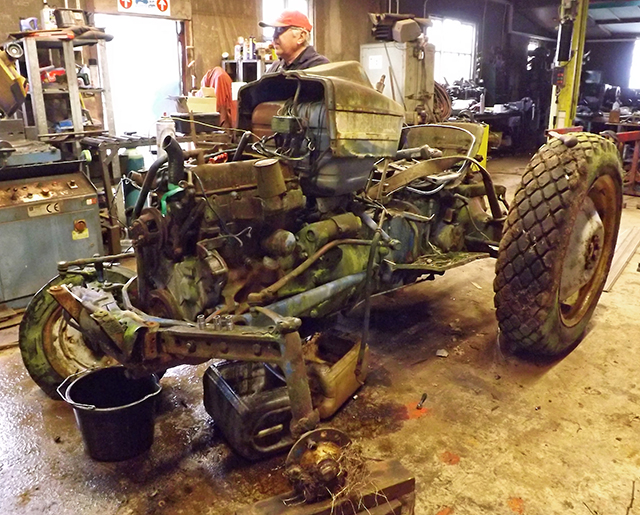
The found-under-a-hedge-in-Kent Ford 3000 was in quite a state when it arrived but, once the engine had been rebuilt, provided the basics needed to create the rea half of ‘Mini D’
The mechanics of undertaking the project at home were made possible for Michael by the fact that he was able to equip his workshop with some of the large machinery that had been used in his manufacturing business. Kit such as a lathe, pillar drill, mechanical saw, heavy-duty welder and a whole array of hand tools and equipment, made the job a practical proposition.
Altogether, the project took about 18 months to complete and, once the rear engine’s rebuild had been completed, Michael got straight into the design and manufacture of the chassis rails and strengthening members needed to connect the two tractors securely to the hydraulically-operated turntable in the middle. “Because Doe never worked with the 3000, I had nothing to base my design on,” he explained, “so had to fabricate bespoke fixings at the back end of the rear tractor, to fit the bolt layout around the bell housing.”
Simple approach
“With regard to the turntable that was needed to provide the articulation at the centre of the tractor, I opted to follow Doe’s earlier, three-plate design. They switched to a ball bearing-based system on later models, but I couldn’t deal with that, so stuck with the simpler approach. Of course, manoeuvring the two tractors around inside the workshop was no easy job, once the front wheels and axles had been removed. All the positioning work had to be done very carefully with fork-lift trucks.”
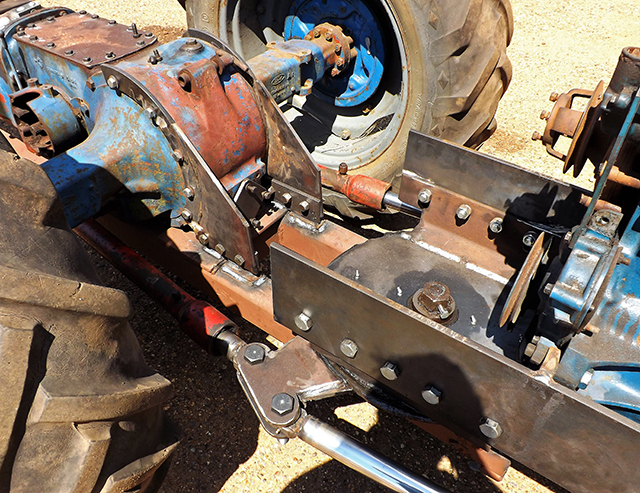
Michael had to design and build his own structural fixings to connect the two tractors, mount the turntable and attach the hydraulically-operated steering
With his engineering experience, and the heavy equipment he had to hand, Michael was able to tackle just about every aspect of the build. “The only item that I couldn’t manufacture myself was the main pivot pin for the turntable, at the centre of the two tractors. This needed to have a 60mm diameter and be threaded. To begin with, I made a smaller version, but it simply wasn’t strong enough to take the loadings, so I had to outsource the making of that.
“Doe used 20mm steel plate for the turntable and, because my machine was going to be smaller and less powerful, I thought I’d be able to get away with 12mm steel. But, once I’d put the two halves together and carried out a few field trials, it was clear from the distortion that 12mm plate wasn’t up to the job. So, I was forced to cut-out the whole turntable assembly and replace it with one made from 20mm thick steel.”
Convenient hydraulics
“One of the beauties of the 3000, and its suitability for this conversion, was that the engine features an external hydraulic pump, which allowed me to simply tap the hydraulics for the steering off that. The steering is very powerful, and can rotate the front tractor with ease, even with the vehicle at a standstill. The hydraulic rams used (two on each side) were taken from Massey Ferguson loaders. Explaining how the engines, gearboxes, clutches and other control mechanisms were linked and synchronised, would take another dedicated article. But, after some reference to the way Doe did things, I’m happy with my solutions, and can confirm that all aspects perform well.
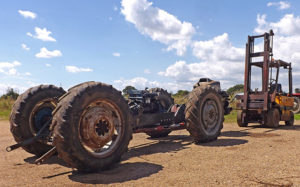
Putting the two halves together required the help of a fork-lift truck as both the tractors became awkwardly immobile once their front wheels had been removed
“One of the most frustrating aspects of the whole build was the painting. I’d put everything together to make sure it was all fully functional but, of course, when it came to painting, the whole lot had to be stripped down again. This really was the worst part of it; a real chore that was very boring and took me about three months to complete. It’s all such heavy work – and I’m not getting any younger – but, luckily, I have a like-minded friend, Paul, who was happy to give me a hand when needed. I did all the painting myself, spraying with traditional enamel. I’m not a fan of using modern, two-pack paints on old tractors, preferring to stick with an original-type finish.
“Once I’d finished the tractor and it was running as I wanted, the initial, shake-down testing revealed a ground clearance issue, necessitating the fitting of larger wheels. You might imagine that that would be a simple operation, but far from it. The Ford 3000 runs on 28in.diameter rear wheels, and I reckoned that an increase up to 32-inch ought to do the trick. However, the only suitable replacements I could find were from a David Brown but, they wouldn’t fit onto the Ford hubs. The only option was to cut out the centres from the new wheels, and replace them with new centres fabricated to match the Ford hub.”

The central articulation makes ‘Mini D’ surprisingly manoeuvrable, given its length. The steering lock available is far greater than on a conventional tractor
Which plough?
“One of the main objectives for the new tractor was to use it for competitive ploughing, but selecting a suitable plough wasn’t straightforward, either. The problem with the regular 3000 is that it doesn’t have very much lifting capacity, and the standard set-up would certainly have struggled to manage the four-furrow plough I wanted to use; the top link simply wouldn’t be strong enough. My solution was to use a semi-mounted plough, and I found a four-furrow, Ransomes TS90 on eBay, that was in surprisingly good condition. But I had to drive to Cumbria to collect it!
“However, in standard trim, the TS90 was far too heavy to be picked up by the tractor, so I decided to fit a hydraulically-operated wheel at the back to lift and support that end, and rely on the hydraulics on the tractor to take care of the front end. Then I realised that, with the tractor/plough combination measuring about 35 feet long, general manoeuvrability would be greatly enhanced if the rear wheel on the plough was made steerable.
“To achieve that, I fitted a rigid linkage between the rear wheel – which was one of the surplus, 3000 front wheels – and the bar to the front linkage of the plough so that, when the angle between the plough and the tractor altered during turning, the rear wheel moved an appropriate amount to steer the back of the plough in the correct direction.”
Movement issues
Another consequence of the new machine’s length – and weight – was that conventional, twin-axle trailering was out of the question. “I didn’t manage to hit my three-tonne weight target,” Michael told me, “and the finished unit ended up tipping the scales at nearer four tonnes. Factor-in the plough and the payload became even heavier and more awkward to move. So the only solution was to buy another lorry with a flatbed that could carry the tractor, and a tow hitch so that the plough could be pulled on a trailer behind.

At some 35 feet long with the Ransomes TS91 plough fitted, Michael considered that a rear-steer, hydraulically-adjustable wheel was needed at the back of the plough. He used one of the Ford 3000 front wheels for this
“Concerning choice, I had some quite specific requirements. I wanted an older vehicle without the complication of computer-controlled engine management, and with a paper disc-type tachograph. I also wanted a hydraulically-operated tailgate plus a sleeper cab that I could use at shows. I eventually settled on a 1996 Iveco 150 E18 which, although it wasn’t the make and model that I’d have gone for out of choice, is 28 feet long and meets all my requirements.
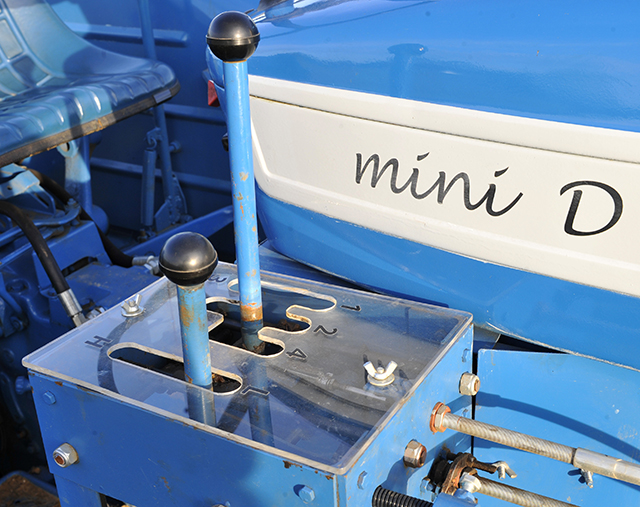
Neatly-packaged gear and drive selection
“It’s a simple vehicle which is great. I can switch off the batteries and it’s dead, without causing any electrical issues, which means it doesn’t matter how infrequently I use it. On the downside, I bought it with a short MoT, which has now expired, and I know that it requires some structural repairs underneath. So it’s going to become a bit of a project over the winter, and I’m planning to remove the body so that I can sort out the chassis properly.
“I used it to transport the tractor and plough successfully to half a dozen local shows last season, before the MoT ran out, and everything was fine. It’s certainly a long vehicle with the trailer attached, but my previous HGV experience means I’m not fazed by that.
“I’ve not come across anyone else ploughing with a similar vehicle, so ‘Mini D’ always causes quite a stir. I would say that it’s harder to plough well with it than it is with a conventional tractor and, using the four-furrow plough makes opening-up quite a challenge. I compete in the ‘two-furrow classics’ class and, so far, have managed a couple of thirds and two second places. Working with this combination is certainly a learning process, but I’m getting better and am loving the challenge. I plan to do more next season, and to travel further afield.”
Michael should be justifiably proud of what he’s achieved with this unique project. He’s created a machine that very much follows the aims and objectives of Ernest Doe & Sons, and yet he’s done so in a way that required so much more ingenuity and mechanical know-how than would have been the case if he’d simply copied an existing model.
‘Mini D’ is a fully-functional and utterly capable tractor which, as I can confirm from personal experience, is easy and addictive to drive. You can’t fail to be impressed by the presence of the thing, and the quality to which it’s been finished – without over-egging the pudding – makes Michael’s creation a very special and desirable tractor indeed.

Michael loves driving and using his creation, and really appreciates its power delivery and four-wheel-drive capability
To subscribe to Ford & Fordson Tractors, click here



